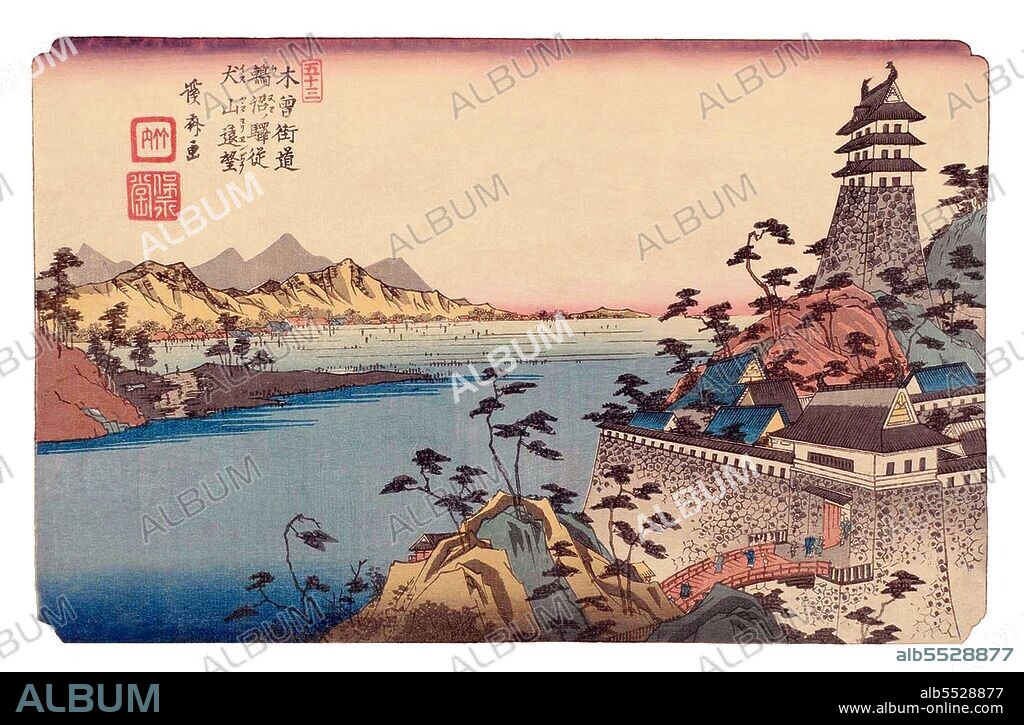alb5528877
Japan: Unuma-juku (???), Station 52 of 'The Sixty-Nine Stations of the Nakasendo (Kisokaido) ' Keisai Eisen (1835-1838)

|
Ajouter à une autre Lightbox |
|
Ajouter à une autre Lightbox |



Avez-vous déjà un compte? S'identifier
Vous n'avez pas de compte ? S'inscrire
Acheter cette image

Titre:
Japan: Unuma-juku (???), Station 52 of 'The Sixty-Nine Stations of the Nakasendo (Kisokaido) ' Keisai Eisen (1835-1838)
Légende:
Traduction automatique: Les soixante-neuf stations du Kiso Kaido (???????? Kiso Kaido Rokujukyu-tsugi) ou Soixante-neuf stations de la route de Kiso, est une série d'?uvres ukiyo-e créées par Utagawa Hiroshige (1797-1858 ) et Keisai Eisen (1790-1848). Il y a 71 gravures au total dans la série (une pour chacune des 69 stations de poste et Nihonbashi ; Nakatsugawa-juku a deux gravures). Le nom commun du Kiso Kaido est « Nakasendo » ou « Central Mountain Highway », de sorte que cette série est aussi communément appelée les soixante-neuf stations du Nakasendo. Le Nakasendo était l'une des cinq routes construites sous Tokugawa Ieyasu, une série de routes reliant la capitale historique d'Edo au reste du Japon. Le Nakasendo reliait Edo à Kyoto, alors capitale. C'était une route alternative vers le Tokaido et traversait la partie centrale de Honshu, donnant ainsi naissance à son nom, qui signifie «Central Mountain Road». Le long de cette route, il y avait soixante-neuf stations de poste différentes ( -shuku ou -juku ), qui fournissaient des écuries, de la nourriture et un logement aux voyageurs. Eisen a produit les 11 premiers tirages de la série, de Nihonbashi à Honjo-shuku, s'étendant de Tokyo à la préfecture de Saitama. Après cela, Hiroshige a repris la production de la série.
The Sixty-nine Stations of the Kiso Kaido (???????? Kiso Kaido Rokujukyu-tsugi) or Sixty-nine Stations of the Kiso Road, is a series of ukiyo-e works created by Utagawa Hiroshige (1797-1858) and Keisai Eisen (1790-1848). There are 71 total prints in the series (one for each of the 69 post stations and Nihonbashi; Nakatsugawa-juku has two prints). The common name for the Kiso Kaido is 'Nakasendo' or 'Central Mountain Highway', so this series is salso commonly referred to as the Sixty-nine Stations of the Nakasendo. The Nakasendo was one of the Five Routes constructed under Tokugawa Ieyasu, a series of roads linking the historical capitol of Edo with the rest of Japan. The Nakasendo connected Edo with the then-capital of Kyoto. It was an alternate route to the Tokaido and travelled through the central part of Honshu, thus giving rise to its name, which means 'Central Mountain Road'. Along this road, there were sixty-nine different post stations (-shuku or -juku), which provided stables, food, and lodging for travelers. Eisen produced the first 11 prints of the series, from Nihonbashi to Honjo-shuku, stretching from Tokyo to Saitama Prefecture. After that, Hiroshige took over production of the series.
Crédit:
Album / Pictures From History/Universal Images Group
Autorisations:
Modèle: Non - Propriété: Non
Questions sur les droits?
Questions sur les droits?
Taille de l'image:
5100 x 3349 px | 48.9 MB
Taille d'impression:
43.2 x 28.4 cm | 17.0 x 11.2 in (300 dpi)
Mots clés:
ANDO HIROSHIGE • ART (CATÉGORIE) • ART • ART, PEINTURE • ASIE • ASIE, CONTINENT • CONTINENT ASIE • DIPLOMATIE • HIROSHIGE UTAGAWA • HIROSHIGE, ANDO • HISOIRE • HISTOIRE • JAPON • JAPONAIS • JAPONAISE • METIER • ORNEMENT, JAPONAIS • PEINTURE • TABLEAU • TABLEAUX • TOKIO • TOKYO • TRANSPORT
 Pinterest
Pinterest Twitter
Twitter Facebook
Facebook Copier le lien
Copier le lien Email
Email
